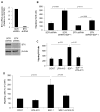Role of Bruton's tyrosine kinase in myeloma cell migration and induction of bone disease
- PMID: 23456977
- PMCID: PMC3971999
- DOI: 10.1002/ajh.23433
Role of Bruton's tyrosine kinase in myeloma cell migration and induction of bone disease
Abstract
Myeloma cells typically grow in bone, recruit osteoclast precursors and induce their differentiation and activity in areas adjacent to tumor foci. Bruton's tyrosine kinase (BTK), of the TEC family, is expressed in hematopoietic cells and is particularly involved in B-lymphocyte function and osteoclastogenesis. We demonstrated BTK expression in clinical myeloma plasma cells, interleukin (IL)-6- or stroma-dependent cell lines and osteoclasts. SDF-1 induced BTK activation in myeloma cells and BTK inhibition by small hairpin RNA or the small molecule inhibitor, LFM-A13, reduced their migration toward stromal cell-derived factor-1 (SDF-1). Pretreatment with LFM-A13 also reduced in vivo homing of myeloma cells to bone using bioluminescence imaging in the SCID-rab model. Enforced expression of BTK in myeloma cell line enhanced cell migration toward SDF-1 but had no effect on short-term growth. BTK expression was correlated with cell-surface CXCR4 expression in myeloma cells (n = 33, r = 0.81, P < 0.0001), and BTK gene and protein expression was more profound in cell-surface CXCR4-expressing myeloma cells. BTK was not upregulated by IL-6 while its inhibition had no effect on IL-6 signaling in myeloma cells. Human osteoclast precursors also expressed BTK and cell-surface CXCR4 and migrated toward SDF-1. LFM-A13 suppressed migration and differentiation of osteoclast precursors as well as bone-resorbing activity of mature osteoclasts. In primary myeloma-bearing SCID-rab mice, LFM-A13 inhibited osteoclast activity, prevented myeloma-induced bone resorption and moderately suppressed myeloma growth. These data demonstrate BTK and cell-surface CXCR4 association in myeloma cells and that BTK plays a role in myeloma cell homing to bone and myeloma-induced bone disease. Am. J. Hematol. 88:463-471, 2013. © 2013 Wiley Periodicals, Inc.
Copyright © 2013 Wiley Periodicals, Inc.
Conflict of interest statement
Conflict of Interest: JS is the founder of Myeloma Health, LLC, a genomics-based predictive medicine company. He holds stock options in Myeloma Health. The remaining authors declare no competing financial interests.
Figures








References
-
- Mohamed AJ, Yu L, Backesjo CM, et al. Bruton’s tyrosine kinase (Btk): Function, regulation, and transformation with special emphasis on the PH domain. Immunol Rev. 2009;228:58–73. - PubMed
-
- Buggy JJ, Elias L. Bruton tyrosine kinase (BTK) and its role in B-cell malignancy. Int Rev Immunol. 2012;31:119–132. - PubMed
-
- Rawlings DJ, Saffran DC, Tsukada S, et al. Mutation of unique region of Bruton’s tyrosine kinase in immunodeficient XID mice. Science. 1993;261:358–361. - PubMed
-
- Shinohara M, Koga T, Okamoto K, et al. Tyrosine kinases Btk and Tec regulate osteoclast differentiation by linking RANK and ITAM signals. Cell. 2008;132:794–806. - PubMed
Publication types
MeSH terms
Substances
Grants and funding
LinkOut - more resources
Full Text Sources
Other Literature Sources
Medical
Molecular Biology Databases
